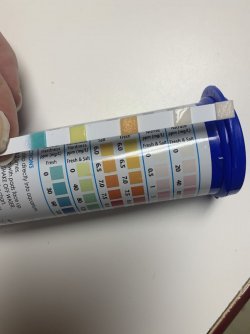Overflow4487
New Member
Good afternoon! I am a brand-new aquarium owner and already am falling in love with this hobby (currently on day 3 of ownership). I was unaware of the Nitrogen cycle when Petsmart told me I only needed to run the tank for 24 hours before putting fish in, so I unfortunately got fish on Sunday without knowing the details. Since then I am doing tons of research to keep my fish alive.
My set-up: I have a 65 gallon tank (4 foot long tank) and I have 6 Giant Danios currently in the tank.
I am on well water but still added conditioner to the water just in case. After doing research, I went back to petsmart and had them cut a piece of used filter and I squeezed that into the tank and left it in the filter for 24 hours. I also used a instant bottle of bacteria to try and start the growth of the good bacteria in my aquarium.
I’m taking a water reading each day and itis a little hard to truly make out the shades...but I believe my ammonia is 0.25 and my nitrite and nitrate appear to be 0. My water ph appears to be between 6.5 and 7.0.
If/when my ammonia reads at 0.5 I am going to begin using seachem prime to render the ammonia harmless to my fish (applying each 24 hours and will double the dose if it goes above 1.0...and will do a 50% water change if it gets to 2.0. That is at least until the nitrite’s begin producing, and then I will be dosing for those as well.
Is this a good strategy for now? I want to make sureI’m doing everything I can for these fish.
mad a secondary question...once my tank does cycle...what would be a good mix of other fish to begin adding to the tank. I was looking at adding 6 neon tetras, 3 Corydoras, 2 Bolivian ram cichlids, and 1 angelfish...but don’t know.
Thanks for anyone’s help!!
My set-up: I have a 65 gallon tank (4 foot long tank) and I have 6 Giant Danios currently in the tank.
I am on well water but still added conditioner to the water just in case. After doing research, I went back to petsmart and had them cut a piece of used filter and I squeezed that into the tank and left it in the filter for 24 hours. I also used a instant bottle of bacteria to try and start the growth of the good bacteria in my aquarium.
I’m taking a water reading each day and itis a little hard to truly make out the shades...but I believe my ammonia is 0.25 and my nitrite and nitrate appear to be 0. My water ph appears to be between 6.5 and 7.0.
If/when my ammonia reads at 0.5 I am going to begin using seachem prime to render the ammonia harmless to my fish (applying each 24 hours and will double the dose if it goes above 1.0...and will do a 50% water change if it gets to 2.0. That is at least until the nitrite’s begin producing, and then I will be dosing for those as well.
Is this a good strategy for now? I want to make sureI’m doing everything I can for these fish.
mad a secondary question...once my tank does cycle...what would be a good mix of other fish to begin adding to the tank. I was looking at adding 6 neon tetras, 3 Corydoras, 2 Bolivian ram cichlids, and 1 angelfish...but don’t know.
Thanks for anyone’s help!!





